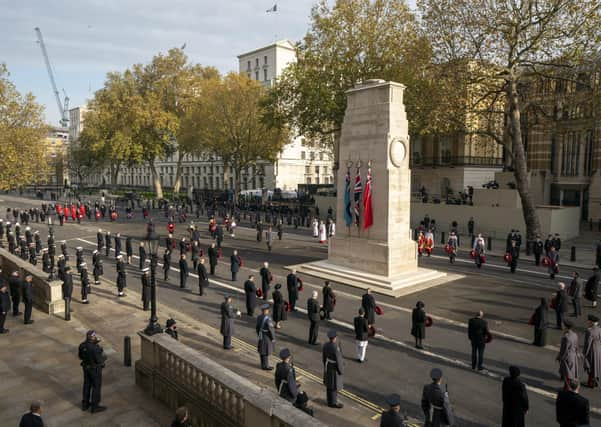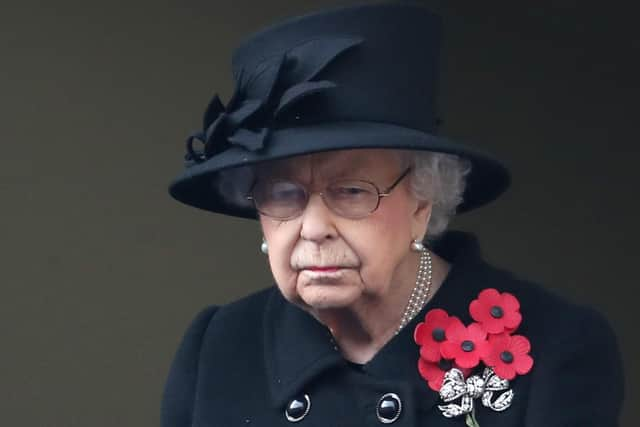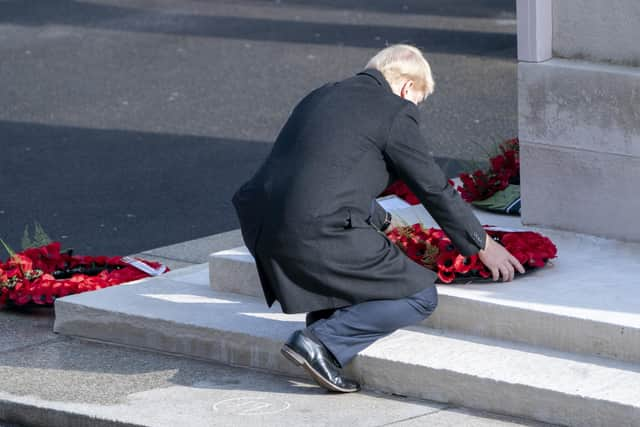Remembrance Sunday: Never before have so few honoured so many


Twenty five former service personnel marching fleetingly along Whitehall to honour, on behalf of all veterans, the fallen of two world wars and more recent conflicts at a time when the world is confronting an invisible enemy – Covid-19.
Over in a handful of minutes at the culmination of this annual service of remembrance, the fact it still went ahead, amid a second lockdown and rising daily death toll, reaffirmed its enduring importance.
Advertisement
Hide AdAdvertisement
Hide AdSocial distancing meant there was little of the heartfelt intimacy, and comradeship, that has been such a defining feature of this national commemoration which, just like services across Yorkshire, had to be scaled back and marked by doorstep tributes instead.


It is said a million people walked past the stone Cenotaph immediately after its unveiling by King Goerge V in November 1920 coincided with the remains of an Unknown Warrior from the First World War battlefields being taken by carriage procession to Westminster Abbey.
More recently, thousands of people have lined this iconic street to watch 10,000 proud veterans parade and remember the one and half million British and Commonwealth service personnel who did not return home from two world wars.
Yet a lack of intimacy and comradeship was made up by a perceptible poignancy as the Queen observed the traditional two minutes silence from a Foreign Office balcony overlooking an eerily quiet and sparse Whitehall – The Last Post haunting at its end.
Advertisement
Hide AdAdvertisement
Hide AdWith five poppies, each representing a different branch of the services, pinned to her coat’s lapel, Her Majesty did not wear the black face mask that she sported at Westminster Abbey when marking the centenary of the Unknown Warrior’s burial by placing a replica of her wedding bouquet on their grave.


But the 94-year-old monarch, who has spent much of the year self-isolating at Windsor Castle with the Duke of Edinburgh, had long made it clear that she would attend this service because of its symbolic importance, not least as time catches up with the Second World War generation 80 years after the Battle of Britain.
To paraphrase Winston Churchill, never before had so few been present to remember so many and Her Majesty’s face was a study of solemnity as the Prince of Wales, his eyes moist with emotion, stepped forward in the shimmering 11am sun to lay a wreath of red poppies on behalf of the Queen, and an eternally grateful nation and Commonwealth, before his own tribute.
The Queen’s simple message on her wreath said “In memory of the glorious dead”, echoing the words on the Cenotaph, while Prince Charles’ handwritten note said “In everlasting remembrance”.
Advertisement
Hide AdAdvertisement
Hide AdHe was followed by the Duke of Cambridge, Earl of Wessex, Princess Royal and Duke of Kent, the latter in his capacity as President of the Commonwealth War Graves Commission. Absent were the Duke of York, whose own reputation remains sullied by scandal, and the Duke of Sussex who now resides in Los Angeles with his family.


Nevertheless, this was the largest gathering of the Royal Family since the first lockdown with the Duchesses of Cambridge and Cornwall both present on a separate balcony with the Countess of Wessex and Vice Admiral Sir Tim Laurence on a third balcony. But the familiar order of service, withthe strains of Edward Elgar’s Nimrod even more stirring in an empty street, was largely unaltered.
Indeed, a sorrowful Boris Johnson kept his head bowed deep in long contemplation after placing his own wreath to the side of the Cenotaph before Sir Keir Starmer, present for the first time as Labour leader, and other political leaders did likewise.
Four former prime ministers – Gordon Brown, again, being the only absentee – watched on, political differences paused, while five Commonwealth high commissioners, as opposed to 40 in previous years, paid their own respects. Among the observers was Rishi Sunak, with the Chancellor and Richmond MP tweeting that he was “honoured” to “show my gratitude for the brave men and women who sacrificed so much in the service of their country”.
Advertisement
Hide AdAdvertisement
Hide AdPrecision planning meant that chalk marks were clearly visible on the steps of the Cenotaph, and Whitehall itself, to guide participants so that they all kept a strictly observed two metres apart.
They included General Sir Nick Carter, Chief of the Defence Staff, who feared that some veterans might find this Remembrance Sunday a lonely experience. “They traditionally have had the opportunity to get together and talk about their memories and their reflections, but equally to strut their stuff,” he said.
This was echoed by Bob Gamble, assistant director for commemorative events at the Royal British Legion, who said: “Remembrance Sunday is an intrinsic part of what it means to be British and I hope we never lose that.” And it still is judging by how diminished numbers on Whitehall actually added to the day’s special resonance.
Support The Yorkshire Post and become a subscriber today. Your subscription will help us to continue to bring quality news to the people of Yorkshire. In return, you’ll see fewer ads on site, get free access to our app and receive exclusive members-only offers. Click here to subscribe.
Comment Guidelines
National World encourages reader discussion on our stories. User feedback, insights and back-and-forth exchanges add a rich layer of context to reporting. Please review our Community Guidelines before commenting.